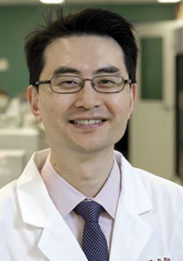Breaking the Paradigm: Early Origins of COPD — Tomoko Betsuyaku, MD, Memorial Symposium (A7)
9:15-11:15 a.m., Sunday
Ballroom D One (Level 3), KBHCCD
Conventional wisdom suggests that COPD is a disease that typically strikes later in life. The reality is that COPD may start in early childhood. It just doesn’t become obvious in most patients until their sixth or seventh decade of life.
“Most clinicians don’t know a lot about the actual origins of COPD,” said Don D. Sin, MD, director at the Center for Heart Lung Innovation (HLI) and professor of medicine at the University of British Columbia, Vancouver, BC, Canada. “Because so many clinicians see COPD patients in their 60s, 70s, and 80s, the impression is that it is a geriatric disease. You may see the final consequences in the geriatric years, but a lot of this has been imprinted in the lungs by birth or early in childhood.”
Dr. Sin is one of three co-chairs for this morning’s session. He shares the platform with Fernando Martinez, MD, director of the Asthma/Airway Disease Research Center and professor of pediatrics at the University of Arizona in Tucson, and Francesca Polverino, MD, PhD, assistant professor of medicine and assistant research scientist at the University of Arizona Asthma/Airway Disease Research Center.

Don Sin
Cigarette smoking has long been viewed as the primary driver of COPD, Dr. Sin said. A growing body of evidence, however, indicates that COPD can be rooted in much more than smoking.
“Babies don’t smoke, but you can see reduced lung function in babies that presents as COPD decades later,” he said. “COPD may be driven by secondhand smoke, air pollution, genomics, abnormal immune response, and dysbiosis of both the lung and the gut microbiomes. Those factors can all have their beginning in the womb.”
The lung and gut microbiomes have their origin in utero, Dr. Sin said, and develop more fully during the first 6 to 12 months after birth. The immune system also develops in the mother’s womb and matures during the first few years of life. Environmental factors, in combination with individual genomics, can give rise to early bronchopulmonary dysplasia, an emerging culprit in the pathogenesis of COPD.
Medical therapy 60 to 70 years later cannot alter those early changes. The only way to prevent these changes that lead to COPD in adulthood are to alter the early risk factors and exposures in childhood.
Reducing the prevalence and the toll of COPD calls for education.
“I remember my dad smoking in the car when I was a kid,” Dr. Sin said. “Not because he wanted to hurt me, but because he didn’t have enough information about the harmful effects that smoking has on the developing lungs. Kids have the most sensitive lungs. If a child’s lung growth is stunted by 20 percent, their risk of COPD is five times higher by age 50. There is a profound amplification of even small deficits in childhood over the decades.”
The new Global Initiative for Chronic Obstructive Lung Disease (GOLD) mentions the impact of lung development on COPD, he continued, but not prominently. Lung growth is not a familiar concept for adult COPD physicians.
“We are breaking the paradigm of COPD,” Dr. Sin said. “This information will profoundly impact not only present COPD but future COPD and the way we practice medicine. We have never thought about targeting kids (and possibly even mothers) for intervention to prevent COPD. The new approach is that in COPD, we can have the biggest impact by targeting kids and their parents. Modifying the factors that drive poor lung growth will have a profound impact on the individual and on society going forward.”
